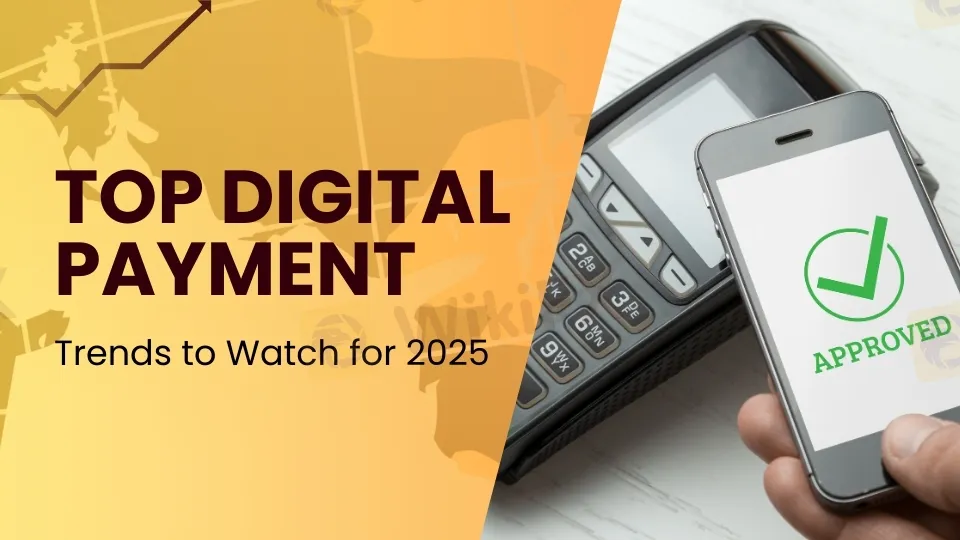简体中文
繁體中文
English
Pусский
日本語
ภาษาไทย
Tiếng Việt
Bahasa Indonesia
Español
हिन्दी
Filippiiniläinen
Français
Deutsch
Português
Türkçe
한국어
العربية
Top Digital Payment Trends to Watch for 2025
Abstract:Discover the top digital payment trends for 2025, including cryptocurrencies, contactless payments, and AI fraud detection, transforming global financial transactions.

The banking industry is fast developing as the rest of the world embraces digitization. Key payment trends are expected to revolutionize the way consumers and organizations trade by 2025. Contactless payments, cryptocurrencies, and innovative technologies such as Central Bank Digital Currencies (CBDCs) are gaining popularity throughout the world.
Cryptocurrencies and Stablecoins on the Rise
Cryptocurrency acceptance has shifted from niche to mainstream, thanks to the growing popularity of stablecoins. These digital currencies, which are tethered to stable assets such as the US dollar, provide the speed and cheap transaction costs of cryptocurrencies while limiting price volatility. As large firms like as PayPal accept stablecoins, we may anticipate further integration into cross-border payments and e-commerce in 2025.
Governments are also moving in with regulatory frameworks to oversee cryptocurrency's wider adoption. This legislative certainty is critical to ensure that companies and consumers may use digital assets for daily transactions in a secure and confident manner.
Contactless Payments: Continued Growth
Contactless payments have a bright future as customer tastes evolve to more convenient, safe, and quick payment alternatives. Tap-to-pay transactions will dominate retail, public transit, hospitality, healthcare, and wearables. Governments and companies throughout the globe are spending extensively on infrastructure to enable contactless technology, ensuring that it becomes a standard across established and developing economies.

CBDCs and National Currency Futures
The worldwide growth of Central Bank Digital Currencies (CBDCs) is an important trend to follow in 2025. China and the United States are spearheading trial initiatives aimed at streamlining cross-border transactions and increasing financial inclusion. Unlike decentralized cryptocurrencies such as Bitcoin, CBDCs provide a government-backed alternative with the potential to fundamentally transform global payment infrastructures and regulatory frameworks.
Buy Now, Pay Later Grows in 2025
Buy Now, Pay Later (BNPL) services are becoming more popular as customers seek more flexible payment choices. BNPL offers customers the ability to pay for products in interest-free installments, making it a popular option among younger buyers. However, regulatory monitoring is rising due to worries about consumer debt and term transparency, implying that new criteria will be developed to safeguard the viability of this payment option.
Detecting Fraud using AI and Machine Learning
As the number of digital payments grows, so do security risks. Financial institutions are investing in artificial intelligence (AI) and machine learning (ML) to tackle cybercrime. These modern techniques aid in the detection of Fraud in real time by analyzing large volumes of data and spotting suspicious patterns prior to transaction completion. As fraudsters grow more clever, AI will remain critical for increasing security and improving the whole payment experience.
Embedded Payments for Easy Transactions
The use of integrated payments is altering how customers engage with digital financial services. This technology enables non-financial platforms to integrate payment options directly into their offerings. Companies such as Uber and Amazon are already employing integrated payments, which allow customers to make purchases without leaving the site. As we approach 2025, this tendency will spread to areas such as e-commerce and healthcare, improving user experience and client retention.
Conclusion
Significant advancements, such as cryptocurrency, contactless payments, and AI-driven fraud detection, will shape the digital payment ecosystem in 2025. CBDCs and BNPL services are expanding, and companies and consumers must adapt to this changing financial ecology. Financial institutions, technology firms, and e-commerce organizations will be better positioned to handle the future of payments if they keep ahead of these trends.
Stay updated on the latest developments in the digital payment landscape! Visit WikiFX News now for more insights on upcoming trends shaping the financial world.

Disclaimer:
The views in this article only represent the author's personal views, and do not constitute investment advice on this platform. This platform does not guarantee the accuracy, completeness and timeliness of the information in the article, and will not be liable for any loss caused by the use of or reliance on the information in the article.
Read more

Russia to Fully Ban Crypto Mining in 10 Regions Starting January 1, 2025
Starting from January 1, 2025, Russia will implement a comprehensive ban on cryptocurrency mining in 10 regions for a period of six years. The ban will remain in effect until March 15, 2031.

The Hidden Checklist: Five Unconventional Steps to Vet Your Broker
Forex broker scams continue to evolve, employing new tactics to appear credible and mislead unsuspecting traders. Identifying these fraudulent schemes requires vigilance and strategies beyond the usual advice. Here are five effective methods to help traders assess the legitimacy of a forex broker and avoid potential pitfalls.

Malaysia’s Crypto Landscape: Adapting Amidst Global Ambitions
The United States is intensifying its efforts to become a global cryptocurrency hub under President-elect Donald Trump. Experts believe this move could prompt countries, including Malaysia, to reassess their regulatory approaches toward digital assets.

SEC Approves Hashdex and Franklin Crypto ETFs on Nasdaq
The SEC has approved crypto index ETFs by Hashdex and Franklin Templeton, including Bitcoin and Ethereum, marking a milestone in crypto asset investment.
WikiFX Broker
Latest News
AIMS Broker Review
The Hidden Checklist: Five Unconventional Steps to Vet Your Broker
Russia to Fully Ban Crypto Mining in 10 Regions Starting January 1, 2025
YAMARKETS' Jingle Bells Christmas Offer!
Why is there so much exposure against PrimeX Capital?
MTrading’s 2025 "Welcome Bonus" is Here
Doo Financial Obtains Licenses in BVI and Cayman Islands
CFI’s New Initiative Aims to Promote Transparency in Trading
Currency Calculator


